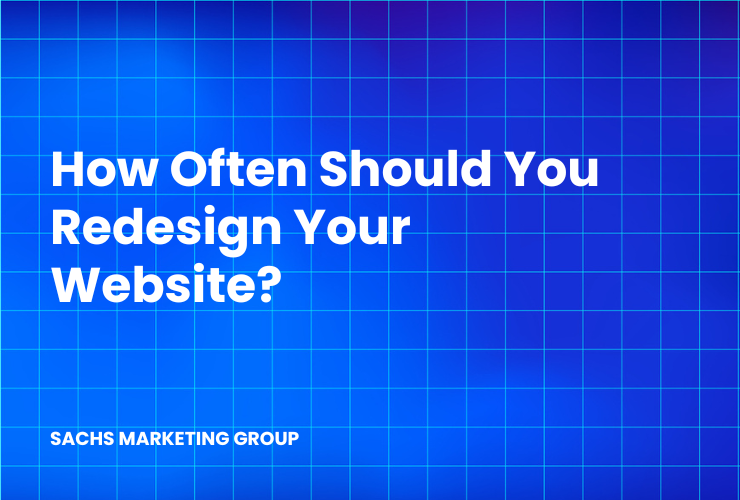As a general guideline, you should redesign your website every 2-3 years. This timeframe ensures your site stays aligned with the latest design trends, technology advancements, and user expectations.
Your website is responsible for making a good first impression on your customers. As website design trends and technologies evolve, so should your website to maintain relevance and effectiveness.
If you let your website design become outdated, it could make a poor first impression on your visitors, costing you potential customers.
In this article, we explore how often you should redesign your website.
Overview
How Often Should You Redesign Your Website?
Determining the right time to redesign your website is crucial. It’s not just about keeping up with design trends – it’s about maintaining a competitive edge.
We’ve written about the importance of web design and what makes a good website design in the past, so we’re exploring how often you should redesign your website to ensure your website doesn’t become outdated and cost you visitors (or customers).
Here’s how often you should redesign your website.
Every 2-3 Years as a General Guideline
Adhering to a 2-3 year redesign cycle is a strategic approach. This timeline aligns well with the pace at which digital technology and user expectations change, ensuring your website stays caught up.
Determining the optimal frequency for a website redesign is more than just a matter of keeping up with the latest design trends – it’s a strategic decision critical for staying competitive in a rapidly evolving digital landscape. Typically, it’s advisable to consider a redesign every 2-3 years. This timeframe aligns with the pace at which technology, user preferences, and digital marketing strategies evolve.
As new design standards emerge and user expectations shift, regularly updating your website ensures it remains functional and reflects your brand’s current values and objectives.
Moreover, regular redesigns are about more than aesthetics – they’re an opportunity to enhance website functionality, improve user experience, and ensure the site is optimized for the latest SEO practices.
A fresh, updated website is more likely to attract and retain visitors, convert leads, and maintain a solid online presence. Therefore, regularly assessing and updating your website is integral to maintaining its effectiveness as a critical business tool in the digital age.
Related: 10 Questions to Ask When Redesigning a Website
7 Reasons to Redesign Your Website
In the digital world, your website is often the first point of interaction with your customers, acting as a critical representation of your brand and business.
As such, keeping this vital asset up-to-date and functioning at its best is essential. A redesign can breathe new life into your website, aligning it with current standards and expectations.
Here are some reasons why you should redesign your website:
1. Outdated Design
An outdated design can significantly impact your brand’s perceived credibility and professionalism.
A modern and aesthetically pleasing design is vital in a world where visual appeal is crucial in user engagement. Keeping your website’s design current ensures it remains appealing to current and potential customers. This involves more than just visual updates – it involves experience principles, making it intuitive and engaging.
A website that looked cutting-edge a few years ago might now be behind the times, potentially driving away tech-savvy audiences looking for current trends.
2. Poor Performance
Poor performance in a website can encompass a range of issues, from slow loading times to unresponsive pages, which can drastically reduce user satisfaction.
Users expect quick, efficient, and seamless experiences. If your website could be faster, it would make it easier for visitors and positively impact your SEO rankings, as search engines prioritize the user experience.
A redesign can help significantly improve website performance, ensuring faster load times, smoother navigation, and, ultimately, a more positive user experience.
This is crucial for keeping visitors on your site longer and encouraging them to engage with your content or services.
3. Business Rebranding
When a business undergoes rebranding, the website must reflect these changes. A redesign can align your website with the new branding elements – a change in logos, color schemes, messaging, or overall aesthetic.
Brand consistency across all platforms is crucial for brand recognition and customer trust. Additionally, a rebranded website can signify growth and evolution to your audience, showcasing your business’s commitment to staying relevant and adapting to new trends or market demands.
It’s an opportunity to re-introduce your business to the market and make a strong, updated impression.
4. Changes in Business Goals
A shift in business goals often necessitates a website redesign to ensure the digital presence aligns with the new direction.
Whether targeting a different audience, launching new products or services, or repositioning your brand, your website should accurately reflect these changes. An updated website can communicate your revised mission, values, or offerings more effectively, ensuring that your online presence is congruent with your business strategy. This alignment is crucial for consistently attracting the right audience and opportunities aligning with your new business objectives.
In this context, a redesign is a strategic tool to facilitate and showcase your business’s evolution and growth.
5. User Feedback
User feedback is a goldmine of insights and one of the most compelling reasons to consider a website redesign.
If users report navigation difficulties, issues with accessibility, or general dissatisfaction with their experience, it’s a clear sign that your website needs to be revamped. This is particularly important for e-commerce websites hoping to turn visitors into paying customers.
Incorporating user feedback into a redesign improves the functionality and user experience and shows your audience that their opinions are valued and considered. This can increase user satisfaction, loyalty, and, ultimately, a more effective website.
Addressing user concerns through design improvements can transform the user experience from satisfactory to exceptional.
Related: 12 E-commerce Website Design Tips
6. Security Concerns
In an increasingly prevalent era of cyber threats, ensuring your website’s security is paramount.
A redesign can address existing vulnerabilities, implement updated security protocols, and protect your business and user data from potential breaches.
This might include integrating secure payment systems, updating to the latest versions of software and plugins, and ensuring compliance with data protection regulations. A secure website safeguards against attacks and builds trust with your users, who are more conscious and concerned about their online security than ever.
Neglecting security can have dire consequences, so a redesign focusing on this aspect is often crucial.
7. Technological Advances
Staying abreast of technological advances is another crucial reason to redesign your website.
As new technologies emerge, integrating them into your website can enhance functionality, efficiency, and user engagement. This could mean adopting AI for personalized user experiences, implementing AR/VR for interactive product demonstrations, or leveraging advanced analytics for better user insights.
Embracing these technologies can provide a cutting-edge user experience, setting your website apart from competitors. Moreover, technological advancements can optimize back-end operations, improve website scalability, and offer new ways to interact with and understand your audience.
Keeping up with technology through regular redesigns ensures your website remains relevant and innovative.
Need Help Redesigning Your Website?
Looking for a comprehensive solution to redesign your website? Sachs Marketing Group is here to help.
As a full-service digital marketing agency, we specialize in creating websites that are not just visually stunning but also optimized for performance and user experience. Let us guide you through transforming your website into a powerful tool for your business growth.
Contact us today and schedule a call to discuss your website.
FAQs
Redesigning your website can bring up many questions. Here are some frequently asked questions to help you navigate the decision-making process.
What are the signs your website needs a redesign?
Key signs include outdated design, slow loading times, poor mobile experience, declining user engagement, and lower search engine rankings. These indicators suggest your website is not performing optimally and could benefit from redesigning.
How does a website redesign impact SEO?
A well-executed redesign can significantly improve your SEO. By optimizing site structure, improving loading speeds, and enhancing mobile responsiveness, you can boost your search engine rankings and online visibility.
Can a website redesign improve conversion rates?
Absolutely. A redesign focused on user experience and journey can lead to higher engagement, better navigation, and more compelling call-to-actions, all contributing to improved conversion rates.
How much does a website redesign cost?
The cost can vary greatly depending on your website’s complexity, the redesign’s extent, and the specific services required. It’s best to consult with a professional agency like Sachs Marketing Group for a tailored estimate.
How long does it take to redesign a website?
The timeline for a redesign project can range from a few weeks to several months, depending on the project’s scope, the size and complexity of the website, and the level of customization needed.
Should you redesign your website in-house or hire a professional?
While in-house redesign might be feasible for minor updates, hiring a professional web design company ensures a comprehensive approach, incorporating the latest trends, technologies, and SEO strategies for optimal results.
Conclusion
Regularly updating your website is not just a cosmetic exercise; it’s a strategic business decision.
By keeping your site current every 2-3 years, you’re ensuring that it continues to serve as an effective and engaging platform for your audience and a vital tool for your business.
Contact us today to get the conversation started!












